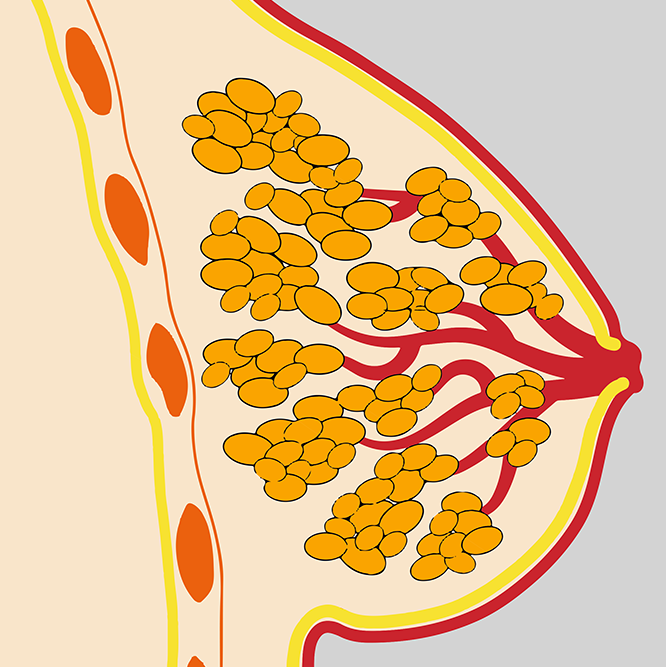Is breast cancer really malignant, or is there a fundamental misunderstanding of biological relationships?
Breast cancer diagnosis: How does it come about? What is the biological conflict behind it, and why does it so often lead to other diagnoses such as bone cancer or lung cancer? With the biological understanding of what exactly happens in our body, what is cause and what is effect, we would like to shed more light on the topic of breast cancer and provide verifiable biological facts.
When talking about breast cancer, it is important to differentiate very precisely which parts of the breast are most frequently affected by ‘cancer’, as the breast consists of different types of tissue belonging to different germ layers. Breast cancer primarily involves tissue changes in the mammary glands (old mesoderm) and the milk ducts (ectoderm), which react completely differently in the conflict-active and conflict-resolved phases. The very imprecise term ‘breast cancer’ often causes diagnostic shock and anxiety with far-reaching biological consequences.
Mammary glands and their biological affiliation
The mammary glands belong to the mesoderm cotyledon, specifically the alt-mesoderm, because they are controlled by the old-brain. The three germ layers entoderm, mesoderm and ectoderm are known from embryonic biology. All tissues and cells in the body can be precisely assigned to one of these germ layers, whereby the connection is fixed and does not change. This results in some interesting correlations such as predictable tissue reactions in the conflict-active and conflict-resolved phase, the microorganisms involved as repair helpers, precise localisation in the brain and precise conflict themes that are firmly related to this tissue. The mammary glands belong to the middle cotyledon, more precisely the old mesoderm.
Tissue changes in the mammary glands

Breast glands / mammary glands – old mesodermal tissue (old brain)
The task of the mother’s mammary glands (marked orange in the picture) is to produce milk for her offspring, as long as the baby cannot eat on its own. The number of mammary glands determines the amount of milk produced and therefore the baby’s nutrient supply. The more mammary glands there are, the more milk can be produced.
The two phases of the special biological programme
Conflict-active phase:
Symptoms: In this phase, there is first an increase in function and later, if necessary, an increase in mammary gland tissue. This can be perceived as a lump in the breast. There is usually no pain, and the affected woman may feel a slight pulling sensation.
Conflict issue: The conflict issue of the mammary glands is the concern that a loved one is dying. Biologically interpreted, the need to protect a being and to nourish it with the breast. A nest conflict is also possible, i.e. concern for one’s own nest.
Biological meaning: The increase in function and subsequent cell proliferation has the purpose of producing more breast milk to help a child whose development has been impaired by a conflict, such as an accident. This biological response is designed to enable the child to recover quickly through breast milk.
Conflict-resolved phase:
Symptoms: Once the conflict has been resolved, the body begins repair processes. Water retention in the affected area leads to swelling, redness and possibly pain. In this phase, the previously formed tissue (tumour) is broken down again by tubercle bacteria, and only the previously formed tissue. The formation of pus is completely normal in the final phase of repair.
Tissue changes in the milk ducts

Milk ducts – ectodermal tissue (new brain)
The milk ducts (marked red in the picture) transport the milk produced to the outside via the nipple, whereby the cross-section of the milk ducts influences the amount of milk flowing through. The larger the cross-section (diameter) of the milk ducts, the more milk can flow to the baby.
The milk ducts react differently to the mammary glands when a conflict shock starts the special biological programme. As the milk ducts are part of the ectodermal tissue, the innermost layer of the milk ducts undergoes cell degradation during the conflict-active phase. This cell degradation leads to a larger cross-section so that more milk can flow out.
Which conflict issue triggers this special programme?
Conflict issues relating to pregnancy, the desire to have children, miscarriages or the hope of being pregnant followed by disappointment when the pregnancy test is negative can start this special programme of the milk ducts.
You lose a beloved creature or the need to breastfeed no longer exists. From a biological point of view, the baby is torn from the breast even though it still needs to be suckled. The baby no longer needs to be fed, the milk is no longer needed and should flow out quickly. For this reason, the innermost layer of the milk ducts is broken down in the conflict-active phase, which leads to an enlargement of the cross-section of the milk ducts.
Processes in the repair and healing phase
In the conflict-resolved phase, which is also known as the repair and healing phase, this cell layer is rebuilt with water retention and swelling processes, which can significantly reduce or almost completely close the milk ducts. Any milk that may still be present can no longer flow out, which can lead to a backlog, which increases the swelling processes in the affected breast. Pain or pulling in the breast, as well as increased sensitivity and tenderness to touch are normal during this phase.
As soon as the tissue reconstruction of the innermost layer is complete, the water retention no longer makes sense and disappears. The cross-section of the milk ducts is then back to normal size. If a breastfeeding mother decides to stop breastfeeding, painful engorgement usually follows shortly afterwards. This means that the milk duct programme is in the repair phase with swelling and constriction of the milk ducts. Shortly before this, the conflict-active phase was started for a brief moment with cell degradation and thus enlargement of the cross-section of the milk ducts so that the milk that is no longer needed can flow out.
Why do these tissue changes make sense?
These changes are no coincidence, no stupidity of the body, no fate and also no genetic disposition. They are part of a meaningful biological programme that has been developed to cope with sudden and unexpected conflicts. If a conflict is not resolved quickly, the programme can become more and more extensive, leading to major tissue remodelling – be it cell proliferation in the conflict-active phase or cell degradation in the healing phase.
In addition to the special programme of the mammary glands and milk ducts, other programmes of the ovaries and mammary glands can also be activated and started. These programmes revolve around the topic of having and nourishing offspring, as offspring are necessary for the survival of the family and clan. Depending on how you feel, other special programmes can start and interact with each other – all in a bio-logically comprehensible way.
Consequences of a diagnostic shock
A diagnostic shock such as ‘breast cancer’ can trigger further, independent conflicts that have nothing to do with the so-called metastases, but are separate biological programmes:
- Bone cancer due to a collapse in self-esteem: after a mastectomy, a woman can experience a collapse in self-esteem. This in turn can lead to bone cancer, as the skeletal system is part of the old mesoderm.
- Lung cancer due to fear of death: If a woman learns that friends have died from the same diagnosis, this can trigger a fear of death that results in lung cancer, as the lungs belong to the new-mesoderm.
- Liver cancer due to starvation conflict: The loss of a job and the resulting financial insecurity can lead to starvation conflict, which leads to liver cancer, as the liver is part of the old brain.
- Brain tumour due to swelling: During the healing phase, there may be swelling in the brain that is visible on CT or MRI images. These are natural repair processes that react to specific conflicts.
Conclusion
Biological laws teach us that what we perceive as illness is part of meaningful biological programmes. It is important to recognise these conflicts in terms of cause and effect and to resolve them as quickly as possible. Postponing because you don’t want to or can’t solve the problem leads to major tissue remodelling measures with sometimes severe symptoms, and consequently to anxiety and further potential for conflict.
Knowing and understanding these laws usually leads to less anxiety and more trust in the intelligent processes of nature. If we think more bio-logically, behave and eat accordingly, many major tissue remodelling processes (cancer) can be prevented as they no longer become necessary from a biological point of view.
What are the biological laws?
The biological laws describe how our body reacts to sudden and unexpected conflicts. These laws are divided into five biological laws of nature that help us to understand the processes in the body that we perceive as diseases or cancer.
Reading tip: Introdution to the biological laws (German)


